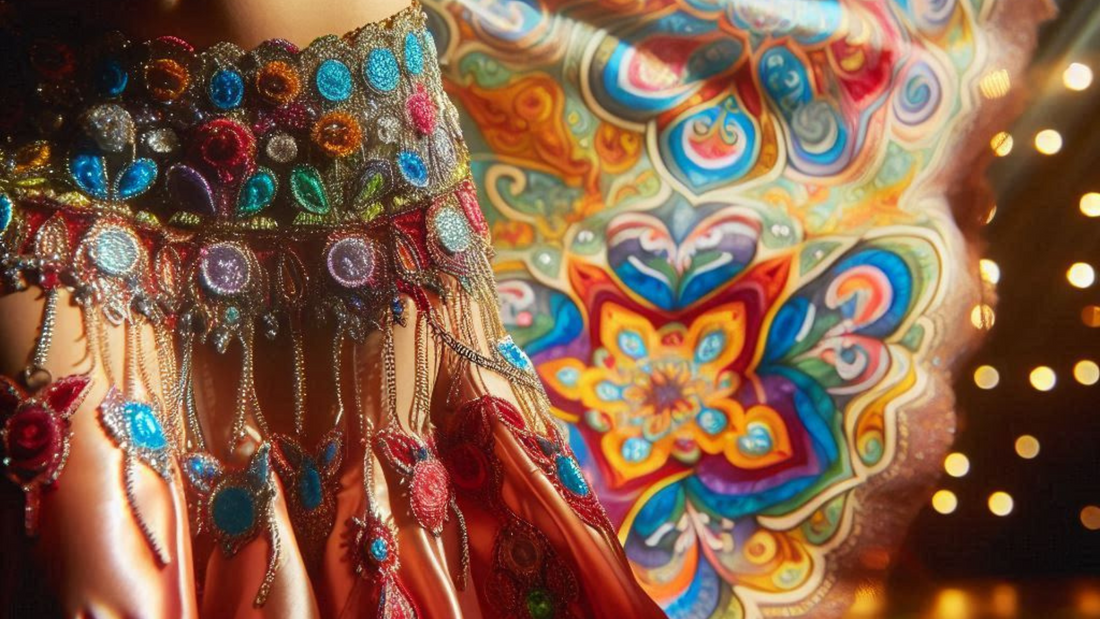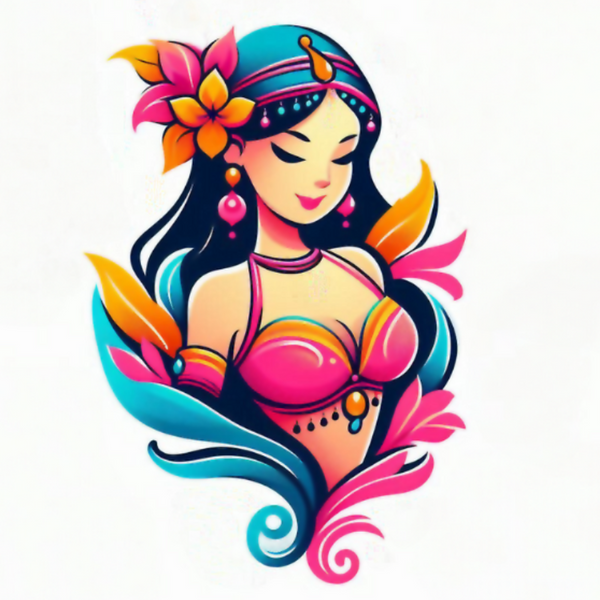
Share
10 Milestones in the Evolution of Belly Dance Costumes
The history of belly dancewear is a fascinating journey through cultural influences, fashion trends, and artistic evolution. From traditional Ottoman designs to modern innovations, each milestone reflects a shift in the art form. Here’s a look at ten milestones in the evolution of belly dance costumes:
1. Shaping the Early Days
Timeline: 14th to early 20th centuries

Courtly Dance
The fusion of Persian, Arabic, and Turkish cultures of the Ottoman Empire led to a distinctive style of performance and attire. The use of luxurious materials and elaborate embroidery highlighted the dancer's status of the era.

Costume Characteristics
Materials: Rich fabrics such as silk, velvet, and brocade were used, often with elaborate gold and silver embroidery.
Designs: Costumes typically included layered skirts, fitted bodices and wide belts adorned with intricate beadwork and coins.

2. A Cultural Renaissance
Timeline: 1920s - 1930s

Gilded Nights
Egypt saw the rise of Raqs Sharqi (Eastern Dance) as a popular form of entertainment in Cairo’s nightclubs and theaters. This period marked a shift towards modernity in both dance and costume. The influence of Western fashion trends led to more revealing and glamorous costumes compared to traditional styles.

Costume Characteristics
Materials: Costumes featured a mix of sheer fabrics, sequins, and beads.
Designs: Common elements included bras adorned with intricate beadwork, the skirts had high slits, fringe, and sequins with matching low-waisted belts. This style set the stage for future costume designs.

3. The Rise of Glamour
Timeline: 1940s - 1950s

Silver Screen
The Golden Age of Egyptian cinema brought belly dance to a broader audience through film stars like Nemat Mokhtar and Zeinat Olwi (Zurah). The glamour and sophistication of these performances extended beyond Egypt, influencing global perceptions of belly dance.

Costume Characteristics
Materials: Costumes were made from luxurious materials such as satin and chiffon, often embellished with rhinestones and sequins.
Designs: Sleek, form-fitting garments paired with flowing skirts that feature high slits and with bold beaded patterns.

4. The Crossroads
Timeline: 1950s - 1960s

Midcentury Development
Belly dance began to gain popularity in the United States in the early 20th century through vaudeville shows and World's Fairs, where it was presented as an exotic art form. By the 1950s and 1960s, belly dance had become a staple in American nightclubs and exotica-themed entertainment. This period saw the development of the American Cabaret style, which adapted traditional belly dance elements to suit Western tastes and nightclub settings.

Costume Characteristics
Materials: Costumes for American Cabaret were designed to be eye-catching and glamorous. Commonly used materials were sequins, velvet, satin, and chiffon.
Designs: Costumes featured layered skirts, beaded bras, and ornate belts. The designs often combined some traditional elements with western contemporary fashion trends.

5. Experimentation
Timeline: 1960s - 1970s

Counterculture
The counterculture movement brought significant influences into many art forms, including belly dance. This period was known for experimentation with bold, vibrant aesthetics.

Costume Characteristics
Materials: Bright, bold colors and metallic fabrics were commonly used. Sequins and fringe were popular choices for adding visual interest.
Designs: Costumes featured eclectic designs introducing new cuts and patterns, this style was known for its unconventional appearance.

6. A New Collective Form
Timeline: 1970s - 1980s
Cultural Inspiration
American Tribal Style (ATS) was developed in the late 60s, blending elements from various dance forms and emphasizing group improvisation. It was influenced by Indian, North African and Romani traditions resulting in a unique blend of styles.

Costume Characteristics
Materials: Costumes often featured earthy tones and tribal patterns, with heavy use of ethnic textiles.
Designs: Key elements included heavy skirts, choli tops, tribal belts and large ornate jewelry. The designs were personalized, reflecting the diverse influences that shaped the style.

7. Pop Culture Influence
Timeline: 1980s - 1990s

Pop Culture
Egypt saw a surge of Western pop culture on belly dance, leading to flashy costumes that focused on glamour and spectacle aimed to appeal to modern audiences.

Costume Characteristics
Materials: Sequins, fringe, and stretch fabrics were commonly used for a flashy and sleek look.
Designs: Costumes featured bold, bright colors, with an emphasis on glamour and visual impact. The designs captured the energy and style of the era’s pop culture.

9. Revival of Golden Era
Timeline: 1990s - 2000s

Back to Roots
A renewed interest developed in the elegant styles of the Golden Era of Egyptian cinema. This revival updated classic designs that defined belly dance during the mid-20th century, maintaining the glamour and detailed aesthetics of that era.

Costume Characteristics
Materials: Rich fabrics such as silk, satin, and velvet, often embellished with intricate beadwork and sequins.
Designs: The return of the iconic, flowing skirts, fitted tops, and low-waisted belts that mirrored the classic styles of Egyptian cinema stars.

10. Bold Modern Trends
Timeline: 2000s - present

Cultural Shift
The innovative ideas of this era are pushing the boundaries of traditional belly dance attire, introducing new materials and daring styles, with a shift towards bold designs in belly dance costumes.

Costume Characteristics
Materials: Fabrics like satin, chiffon and elastane were commonly used, with added embellishments like rhinestones and sequins.
Designs: Costumes featured dramatic cuts including high slits and swooping necklines. The designs blended traditional aesthetics with experimental fashion trends.

Diverse Journey of Evolution
The evolution of belly dance costumes reveals rich cultural influences and artistic innovation. Each milestone in this journey reflects a unique chapter in the story of this dynamic art form, showcasing the diverse and evolving nature of belly dance attire.


